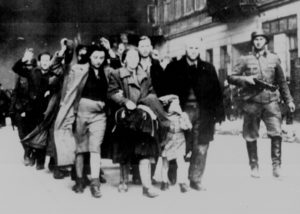The Fallacy of the Armed Populace as Deterrent
 Jewish civilians during the destruction of the Warsaw Ghetto, Poland, 1943.
Jewish civilians during the destruction of the Warsaw Ghetto, Poland, 1943. Disarming a population is part of the process of tyranny, but it’s not the most critical part. Silencing free speech, preventing assembly, circumventing due process, and alienating the people from politics all take priority. Slander and a concerted propaganda campaign against the targeted minority likewise come far before disarmament. Tyranny is only made possible by convincing the masses that the targeted dissidents pose an immediate threat to the nation, and this can only be accomplished by the abolishment of the free press or by convincing the people that they can only rely on government-provided information.
Applying the armed populace as deterrent idea to the Holocaust, it’s a fallacy to believe the Jews didn’t fight back. They did, especially in Poland. German Jews mostly fled—in fact only about 130,000 were murdered, a small fraction compared to the 2.9 million Polish Jews murdered and an even smaller fraction of the six million killed in all. Polish Jews didn’t go through the systematic disarming that German Jews did, and the invasion was so swift that most were unable to flee, so it offers insight into what subjugation without prior disarmament looks like.
The first step in the process wasn’t extermination—it was consolidation. Very few at the time suspected this consolidation would eventually lead to mass extermination. So Polish Jews at that time, many of whom were armed, were forced to make a decision, not between armed resistance and death, but between armed resistance and forced relocation. Most, but not all, chose relocation. Some did choose to fight.
Poland had the largest and most successful underground resistance movement of the war, which inflicted serious defeats on the Nazis and freed thousands of prisoners. It also helped funnel vital intelligence to the Allies during the war. In the end, however, the Polish resistance wasn’t nearly enough to prevent their subjugation. During the second mass deportation from Warsaw to the Treblinka death camp, the Jewish group known as ZOB put up a fierce resistance. The Nazis responded by simply burning the city to the ground, building by building, suffocating thousands of Jews hiding in underground safe houses. After the war the Soviets, seeing the resistance fighters as a threat to communist domination, executed or deported nearly all of them. Further undermining the disarmament argument is the fact that most of the arms used by the resistance were smuggled in to them after the invasion, indicating that their ability to resist hinged far more on will than on prior arms possession.
When armed resistance occurred in the occupied territories, the Nazis responded by committing reprisals against randomly selected civilians in the area. Usually the punishment was at least ten summary executions for every Nazi soldier or sympathizer killed. Other times the closest village would simply be razed to the ground, along with the murder of every man, woman, and child inhabitant. Knowing this, the armed insurgents were forced to make difficult decisions. Often times their families and friends would be raped and murdered if they chose to directly attack the oppressors. They could attempt to remove their relatives from the villages but this was exceedingly difficult due to a lack of sufficient food and shelter in the remote enclaves of the fighters.
The strain that cohabitating civilians placed on logistics and the ability to remain undetected nearly always proved fatal. Armed insurgents not attempting to blend in with the population needed to maintain a small and mobile camp footprint in order to avoid detection. They also needed civilians to stay in the proximal villages in order to supply them with food, medicine, and vital intelligence on the enemy. When the villagers were forcibly relocated, those wishing to openly fight were faced with another difficult decision: allow their relatives to be removed without them and continue the fight there, or agree to be relocated with them in order to attempt to protect them, giving up their arms in the process.
If we were faced with tyranny of one sort or another, declaring ourselves sovereign and openly resisting just wouldn’t work. AR-15s are very adept at shooting school children and concertgoers but fail to suffice as a main armament for denying or controlling territory. When someone in Tampa, Florida, can decimate a patrolling militia in Idaho with a drone and a laser-guided infrared missile from thirty-thousand feet, symmetrical warfare is simply not an option. If an armed patrol came to seize your family, what would you do? While standing and openly resisting might be brave and admirable, it would also likely result in the death not only of you and your family, but of several families near you as well.
These are the tough, real-world decisions, above the chest-thumping rhetoric of those who’ve never been oppressed, that those who suffered through tyranny had to face.
While the Polish resistance was amazingly heroic and legendary, it failed to save most lives or regain the freedom of the Poles, which became a client state to the Soviets for the next fifty years.
The only vaccine to oppression, in the end, is a free and open press. It is the only thing that can truly take on a government bent on the subjugation of a free people.
